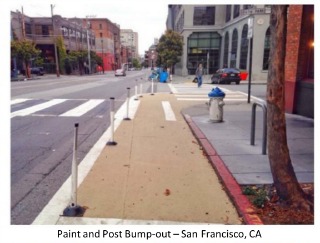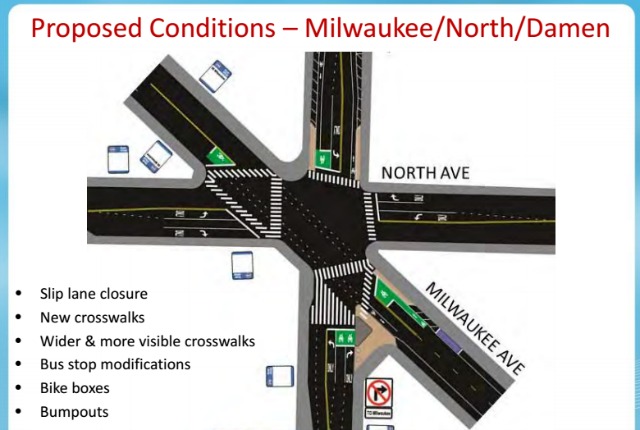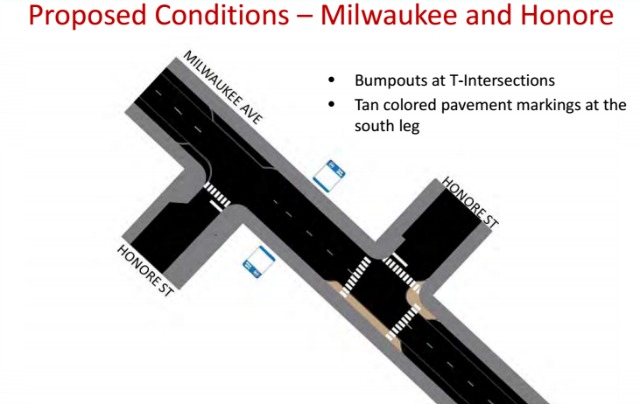Key Safety Changes Planned For Busy Milwaukee Ave Corridor In Wicker Park, But Barely Any Bike Lanes
By Stephen Gossett in News on Jul 14, 2017 2:33PM

Damen at Milwaukee / Photo via CDOT
There won’t be much at all in the way of much-coveted new bike lanes any time soon, but other big changes are shaping up quickly to improve safety along the heavily trafficked Milwaukee Avenue corridor in Wicker Park—including a potential significant revamp of the notorious intersection of Milwaukee, Damen and North avenues that could be right around the corner.
 If all progresses as is, the corridor would see a reduction in speed limit (down to 20 miles per hour), paint/post bump-outs at several crossings, the stripping away of 32 parking spaces (net total) on Milwaukee, between Armitage and Division, and several ped- and bike-friendly additions to Wicker Park’s main intersection.
If all progresses as is, the corridor would see a reduction in speed limit (down to 20 miles per hour), paint/post bump-outs at several crossings, the stripping away of 32 parking spaces (net total) on Milwaukee, between Armitage and Division, and several ped- and bike-friendly additions to Wicker Park’s main intersection.
The proposals put forth Wednesday by the Chicago Department of Transportation at a community meeting in Wicker Park are not officially a final design, officials stressed. (Feedback is still being accepted.) But the design is “getting close to being ready for installation,” Mike Amsden, assistant director of Transportation Planning for CDOT, said.
Amsden stressed at the first meeting, in May, that the focus would be on “low-cost, quick-hit” ideas—hence the lack of real bike lane expansion—but the changes would be myriad. Several of the plans that were previously floated advanced to the current design.
In terms of the Milwaukee/Damen/North intersection, perhaps the biggest change would be the implementation of two new crosswalks, both of which would make official some shortcuts that a lot of pedestrians have already long improvised: a new north-south crosswalk from near Walgreens to the Starbucks corner; and an east-west connection from the Flat Iron Building corner to the Starbucks corner. The idea was previously put forth, but it wasn’t yet clear if it would be ADA feasible—which Amsden on Wednesday confirmed it would be.
(Work on the new crosswalks would likely not start until later this year, or early next year, but CDOT hopes to begin other construction very soon, by late summer.)
Also, the slip lane that connects northbound Damen to southeast-bound Milwaukee would be pedestrianized with bollards, eliminating right turns for vehicles. (The lane sees 33 percent more pedestrian crossings than driving ones, according to CDOT data.) It’s represented by the largest tan splotch on the map below. The other tan markings indicate bumpouts that would be added, which are designed to shorten crossings and add visibility.
Also, the high-foot-traffic crosswalk that links the east and west sides of Damen—at the south end of the intersection—would see a dramatic beefing up, as seen below. And four large, new bike boxes are included.

As for bike lanes, CDOT was sympathetic to the idea of adding more along the bustling Milwaukee stretch as a long-term goal. But Amsden said that even removing a lane of parking wouldn’t allow enough space for a protected bike lane, without also taking the major step of moving curbs. Simply removing on-street parking would create the false perception of a wide street and hurt the pedestrian environment by getting rid of the buffer that parked cars create, CDOT said. And the amount of illegal parking that would take place in a non-protected bike lane on the lively stretch makes a mere dedicated bike lane dangerously suboptimal, Amsden said.
Advocates and attendees meanwhile agreed that the plan is a strong introductory initiative, while also affirming their commitment to seeing those high-quality protected bike lanes sooner than later.
"It’'s a great first step," said Jim Merrell, advocacy director of Active Transportation Alliance, the prominent, local cycling and transit advocacy organization whose petition for bike lanes on the Milwaukee corridor has amassed some 1,500 signatures. "We think it’s a great platform for us to stand on moving forward, to secure the bigger capital improvements sooner than five or ten years down the road—because those crashes are happening today on the corridor."
Amsden said that, in the meantime, the reduced speed limit is a smart step in the effort to reduce dooring crashes on the busy pathway. More than 5,000 cyclists use the Milwaukee corridor every day; and that Milwaukee/North/Damen intersection has the highest concentration of crashes in the city, according to CDOT.
The plan also calls for changes to the Polish Triangle area, with bus-stop modifications, a partial slip-lane closure—which would prevent trucks from turning right from southbound Ashland onto northwest-bound Milwaukee, plus improved street striping. The food-truck and taxi stands would be repositioned but kept in the vicinity.
Also, a very small stretch of bike lanes would land on Milwaukee, “between Wabansias.” (The side street is briefly staggered by the major avenue.) Street conditions near the 606 entrance in Wicker Park would also be improved. Some T-intersections would also have bumpouts added. (The many loading zones on the Milwaukee strip, from Division to Armitage, won't be consolidated, but they would see minor changes to allow for bumpouts.) And a couple of right-turn lanes at intersections would be turned into regular lanes—allowing for turns, but not requiring them.
The full presentation will be available online, at chicagocompletestreets.org, on Wednesday.
